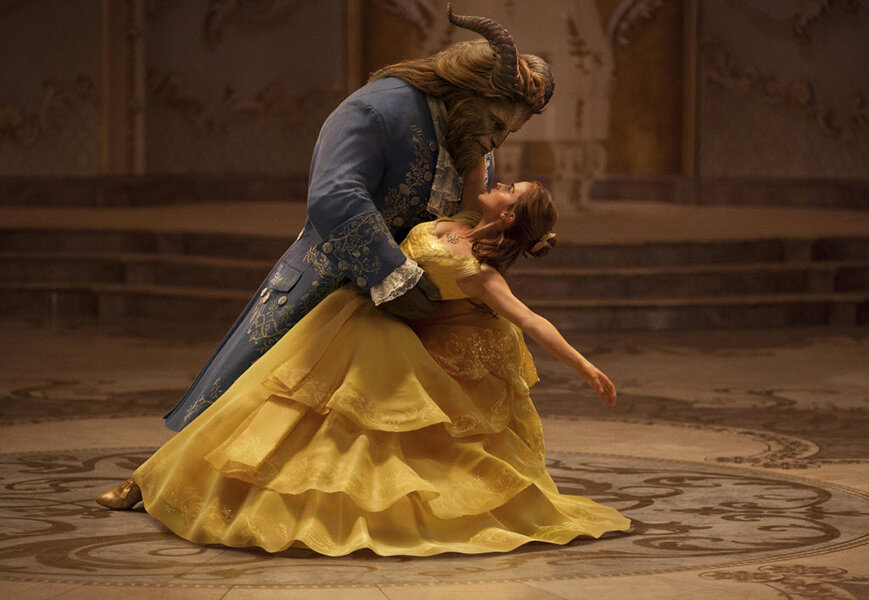'Beauty and the Beast': When a feminist plays a Disney princess
Loading...
Is a “feminist Disney princess” an oxymoron?
“Oh, I’m not a princess,” Belle tells a character in the new live-action version of “Beauty and the Beast.” The actress playing her, Emma Watson, reportedly requested the line.
As to whether she fits the modern definition of feminism? Audiences will get to decide for themselves Friday, when the movie opens in theaters, but culture watchers point out that Belle's intelligence and courage in the original animated film resonated with girls in the 1990s, and marked a departure from earlier Disney heroines.
“I loved the story when it came out in the ’90s, and I loved it for similar reasons that Emma Watson has been saying in her interviews, in that it was a heroine that spoke her mind, and she had some interests outside of the romance,” says Lisa Swain, associate professor of cinema and media arts at Biola University, adding that the original character’s love of reading drew her to the story.
In the 1991 version of the film, the only animated movie to be nominated for a Best Picture Oscar when only five contenders were allowed, the bookish inventor’s daughter had hobbies that went beyond singing with adorable woodland creatures and dreams that included more than waiting for her prince and settling down in a castle.
“The original Belle was very progressive and quite modern for her time, and I think it was a case of kind of defending and protecting her original DNA,” Ms. Watson told USA Today.
Interestingly, Belle’s love of books predates Disney – it was part of the character in author Gabrielle-Suzanne Barbot de Villeneuve’s story, published in 1740, says Bonnie Rudner, an associate professor at Boston College who teaches courses including “Disney and the Wondertale.” “That’s very unusual for women [at the time],” Professor Rudner says.
But after “Mulan” and “Moana” – to say nothing of Katniss Everdeen – filmmakers say they took steps to make sure the outspoken bookworm had enough agency for modern audiences. And what about the Stockholm Syndrome question – in every version of the story, Belle is falling in love with the guy holding her captive. Efforts to address those questions head-on in the new movie range from the cosmetic to the more substantive.
Take the woman portraying her: Watson, who played Hermione Granger in the “Harry Potter” films, has publicly supported issues including schooling for young girls, removing the stigma attached to feminism, and encouraging women becoming involved in politics. In 2014, the United Nations Goodwill ambassador spoke at the UN headquarters about HeForShe, a campaign to encourage men to become involved in discrimination against women.
She and director Bill Condon traded animated Belle’s ballet slippers for a sturdy pair of boots and ditched the corset. And this Belle has a career beyond keeping house for her absent-minded father: This time, she’s the inventor.
“There’s already progress from the last film,” says Nancy Wang Yuen, chair of the department of sociology at Biola University, of the inventor twist.
And Rudner, for her part, says the movie version of the story has as much to say about masculinity as it does feminism.
“Disney is really looking at masculinity,” she says. “What makes a man? Who's a man? ... The [villain] ‘Gaston’ song is, that's one kind of man. And then Beast is another kind of man and he has to learn, he has to be transformed by the love of a good woman. And then [Belle’s father] Maurice is another kind of man, he's the silly, chunky Disney laughable father, he's like a child.... It's interesting. It seems to me like the Disney movie is way more about males than females.”
Rudner notes that the Beast learns how to treat Belle well, while Gaston never does.
“The problem with Gaston is that he doesn't validate anything about Belle. He doesn't appreciate her, he doesn't validate her right to be independent or free or read, as opposed to Beast, who gives her a library, who lets her go,” she says. “[Belle is] so free and she goes here and she goes there,” she says. “We'll see if at the end if she has not just a library but she has her own lab.”
Rudner says she sees more recent Disney characters as having a “pseudo-rebellion.” Characters like Belle are defiant, unlike the early Disney princesses such as Snow White or Cinderella, who are meek and quiet. But unlike last year’s “Moana,” in which the explorer heroine doesn’t have a love interest, the fairy tale happily-ever-afters typically end with a wedding.
“The resolution is still in the romance,” Professor Yuen agrees. “So I'm curious to see whether Disney will try to make it not about that ... that the resolution isn't hinged on the actual union.”
Belle’s ability to judge people based on more than appearances also plays a role in the story’s resonance. While the Beast looks more like Dan Stevens of “Downton Abbey” after the curse is broken, “it is significant that she falls in love with him not knowing that he is going to change to a handsome prince,” Swain says.
She adds, however, that this still has its problems. “I think that's one of the things that makes ‘Shrek’ such an appealing movie,” Swain says. “Instead of him turning into a handsome prince, she turns into an ogre.”
That sends a message, says Swain. “ ‘You love me, you really do see me.’ I wish that there was some kind of hybrid where maybe when [Belle] sees [the Beast], she sees the prince but when everyone else sees him, they still see that [Beast] appearance,” she says. “But yeah, it’s still a fairy tale in the end, right?”








